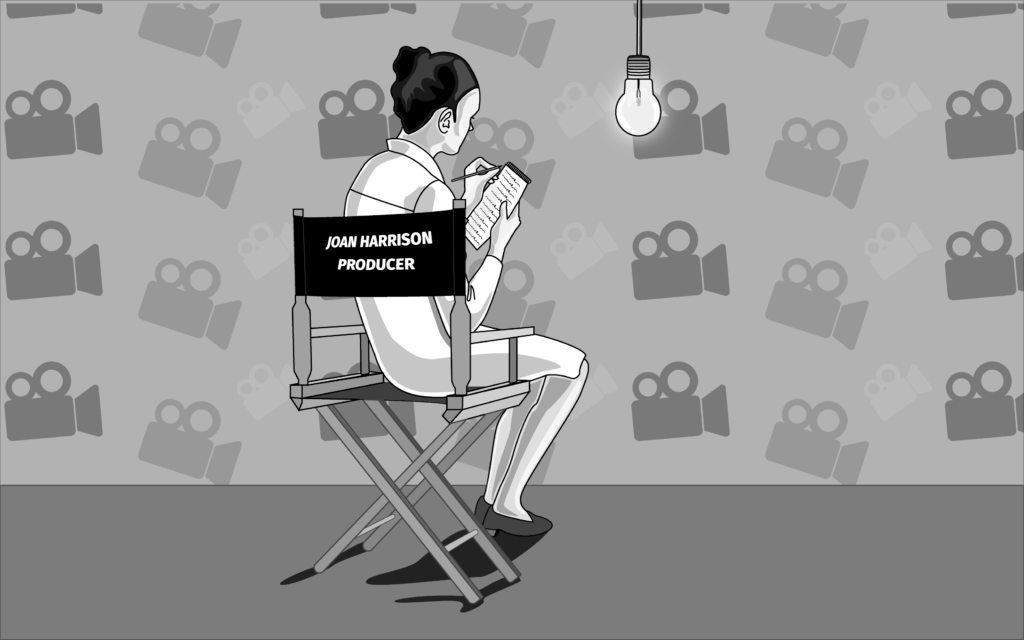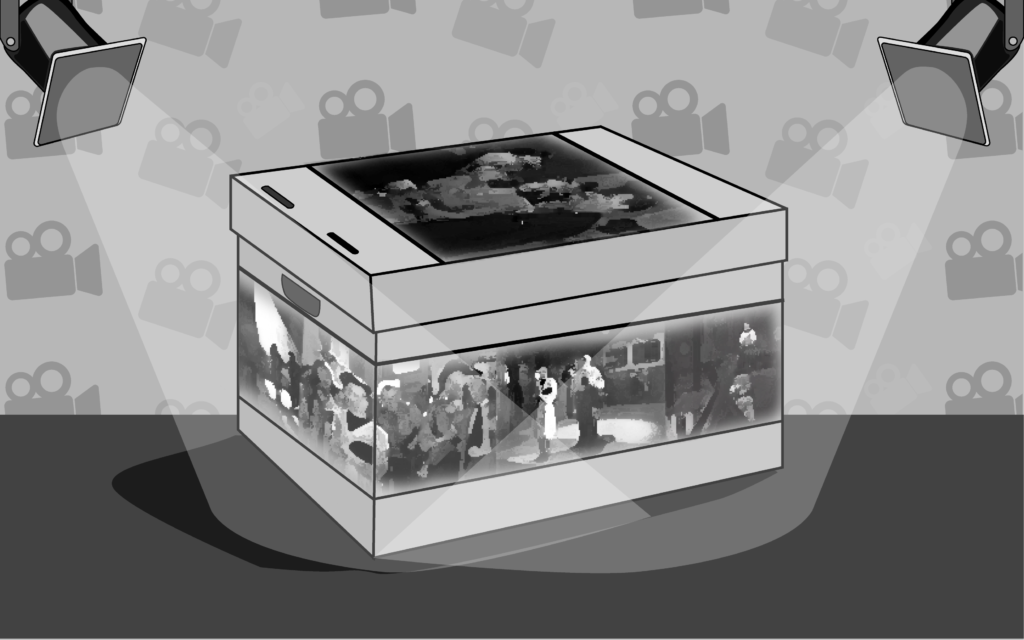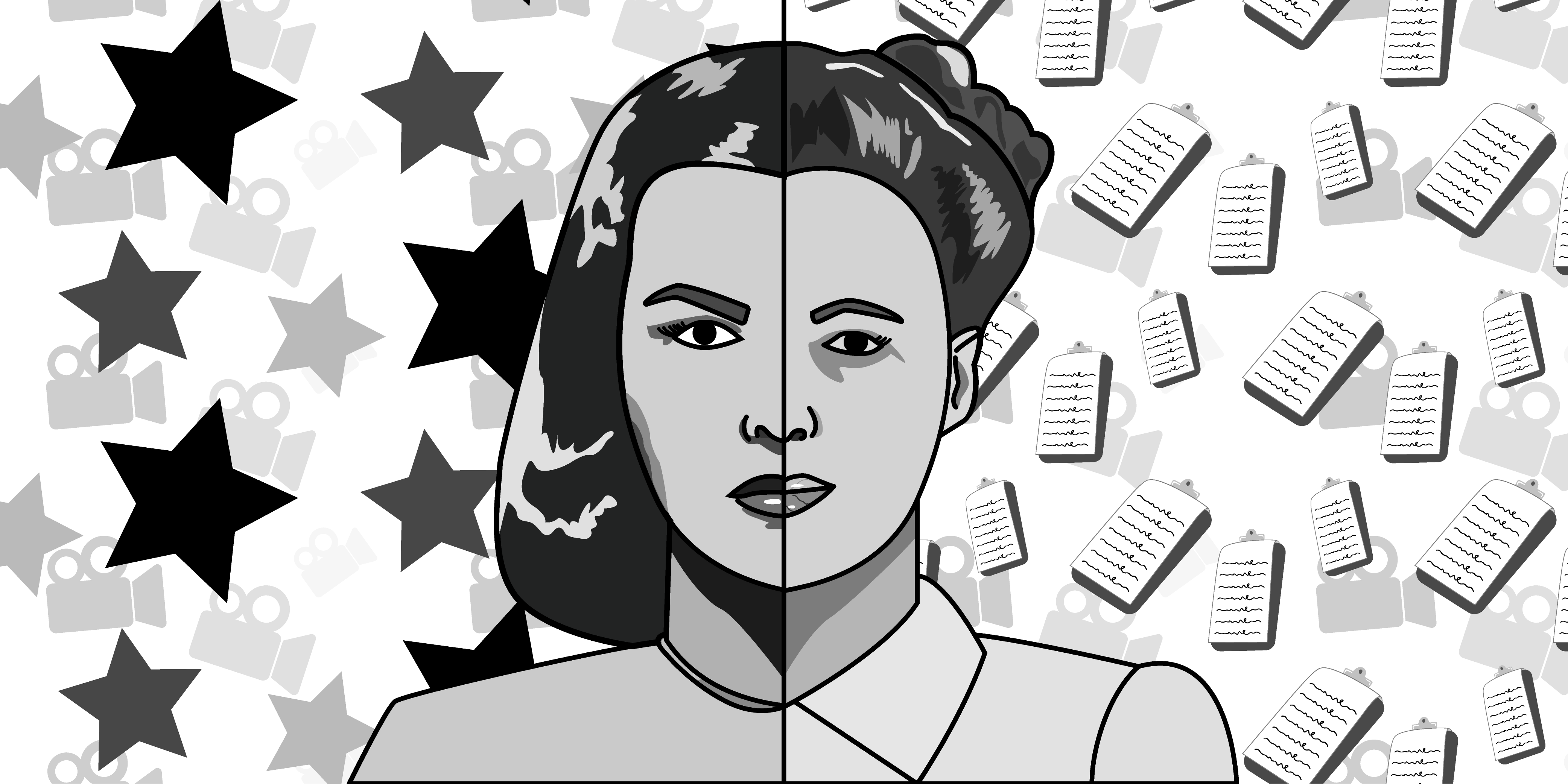Long before Alfred Hitchcock and his marketing team implored moviegoers in 1960 not to share what they had seen with Psycho, there was another film labeled a thriller during its time — and now gets tagged as noir — that had made similar entreaties. The year was 1944, and the picture called Phantom Lady, one of the first Hollywood films that, if it were released in our age, would come with the warning of “Please, no spoilers.” Movie veteran Robert Siodmak directed, a venerable, go-to thriller guy who helmed his endeavors with a firm grip upon a finely calibrated wheel. His gift was for fast jerks of said wheel that could all but launch you bodily from your balcony seat, popcorn in the lap, heart in the throat.
But the picture was really no more Siodmak’s doing — that is, he was not its chief-doer — than we might say a film directed by Robert Wise was a Robert Wise project when also produced by Val Lewton, the resident post-Orson Welles genius at RKO, who, as the studio boasted, excelled at showmanship over braininess, as if the two couldn’t be blended, which is exactly what Lewton did.
Certain producers merit auteur credit as if they are conducing the conductor, displaying a blended ability to interpose without interfering, a most delicate of gifts. And so we might more correctly say that Phantom Lady is the cinematic brainchild of Joan Harrison, a Val Lewton type in her own right, but also entirely her own brand of talent, and a pioneering female one at that in a male-dominated sector of the industry.
Dorothy Arzner had a fantastic run as a director spanning the silent era and on into these same early 1940s when Harrison began her rise. Arzner started in scripts, transitioned to editing, where her invaluable suggestions added up — as she was cagey enough to know — to a form of leverage that in turn helped her land her first directing gigs.
Her métier was the unconventional romance. One might ask, “When is true romance ever conventional?” A fair point that also lands at the heart of the Arzner aesthetic: real life, via an absence of formula, but smatterings of luck, the understanding of when a worthy opportunity is at hand, and the ability to stay the hell out of one’s own way. In these manners are fears overcome, and the best unions realized.
No one in American moviemaking during the era adumbrated this quite so well as Arzner. And so she had her niche, and a hidebound industry appeared content to let her keep it, so long as she stayed relatively close. Her success opened some doors — partially — but hardly floodgates.
Joan Harrison, though, would not require the latter, and was determined to make sure she passed through whatever sliver of an opening she could find. She worked long for this break, eyes fastened on a prize beyond even the lofty goal of directing. For Joan Harrison wanted to do what hardly any woman had ever done in Hollywood, and that was to occupy the producer’s chair. But Joan Harrison had a penchant for achieving what she wished, as if lack of precedent simply meant that someone — namely her — was due.

Pluck is a rare trait in this world, though you might say it was one of Harrison’s chief exports. The Hitchcock comparison is not an idle one. The rotund master learned a thing or two from our Ms. Harrison, as she certainly learned a goodly amount from him.
Born in the summer of 1907 in Surrey, she was hungover one morning in 1933, laying in bed and pondering the degree of her headache, when a friend told her that Hitchcock was looking for a secretary that very day.
Within minutes, Harrison was in her car, zipping over the English countryside. 40 people had already been interviewed, 12 more were queuing in line for their respective grillings, but Harrison overleapt them all, landing the gig. Talk fast, talk smart, finish strong, seemed to be her mantra in these matters, and it served her well.
Perhaps more impressively — and maybe she anticipated this all along — she came to earn Hitchcock’s ultimate approbation, something with which he was generally parsimonious, to understate matters.
In terms of his pictures, he counted on the counsel of his wife, Alma, an auteur in her own right, and arguably — I’d argue it, for one — the single greatest creative silent partner in all of cinema. She was about the only person who could talk him down from something, or talk him up to something else. That is until Joan Harrison and her pluck — and certainly her sense of story — won Hitchcock’s respect, and that of moviegoers, too, who began to notice that there was a new name in the credits of Hitchcock’s films. She wasn’t billed as secretary by then, but rather, voila, screenwriter. Pretty cool, and coolly merited. No old boys’ network for this upstart.
I’m being a touch fatuous. Harrison did not metamorphosize overnight, though she had writerly gifts and, crucially, a writer’s eye.
Hitchcock — a creepy guy who often treated the women he worked with brutally — appears to have had nothing but respect for Harrison. He took her to dinner repeatedly, holding forth on various murders in which he was well-versed. One senses that this was the director’s idea of a boot camp for filmmaking — that he wasn’t merely trying to shock a young lady, or have someone indulge him with his love of telling tales.
For Hitchcock, the business of murder was bound up with the business of making films. In sharing his passion and expertise for the one, he was sharing his passion and expertise for the other. Harrison listened intently, and she learned, developing her own passion for criminology. She recognized Hitchcock as a scholar, after a fashion. A life scholar. His studies focused on bloodshed and the plans and economics of bloodshed, and Harrison learned a lot about devotion to detail.
Hitchcock oriented his films around the visual — obsessively so. Think of his movies: what dialogue do you recall? Anything from The Birds? Yes, we remember the lines about the mother in Psycho and how every boy loves his, but that’s the exception. One reason that Rope doesn’t work particularly well is that it relies on the verbal, which was not Hitchcock’s forte. His moves are written imagistically, rather than through peppy back-and-forth. Harrison was to write in the same fashion, but with her personal stamp, which was more about the indelible human touch — a hat left behind — rather than Hitchcock’s grandeur. Harrison could be tart, but there was more “give” in her filmic sensibility than in Hitchcock’s. She took his masculine touch, and provided an evening feminine aspect.
Harrrison penned parts of Jamaica Inn, Rebecca, Foreign Correspondent, Suspicion, and Saboteur, between 1939 and 1942, helping Hitchcock, in essence, come to America. This was a key interregnum phase for the still-young-early-40s-visionary; his English films were subtle, quietly communicative, asking that the viewer think through and along with what he or she was seeing and hearing — you had to actively experience his films, know which dots to connect.
American cinema traded in greater volume — shouty screwball comedies, bang-bang thrillers, mouthy tough guys and their mouthier molls, melodramas making for moist handkerchiefs.
Harrison bridged the divide — her sensibility was American, and she certainly wasn’t the retiring type. When she did strike out on her own, and a newspaper cub reporter came around to interview her, she snapped a retort that maybe he’d like a photo of her legs if there was doubt on how she had made it as far as she had.
She was cracking wise, of course, but this wasn’t someone prone to blanching, or not finding solutions. Hitchcock, going back to his silent days, signposted his films visually. You could even watch the sound pictures (think about the start of Rear Window, for instance) with the sound off and only be slightly less the wiser.
Harrison enfolded those signposts into dialogue. Hitchcock dialogue would not be flashy, nor tart, under her watch, but she gave it a certain stamp, making it feel Hitchcockian. You remember it, but you don’t think to quote it. She helped him give viewers an argot that turned their focus back to visuals, making them active participants in a movie’s unfurling, both cogs, and partners in a cinematic drama.
No less a dark master — the darkest pulp master of noir — than Cornell Woolrich wrote the screenplay for Phantom Lady, under the pseudonym William Irish, which suggests a corned beef sandwich and a glass of whiskey more readily than a steamy urban thriller. Producer Harrison tied up a lot of her budget in salary to the actor Franchot Tone. She wanted his bankability. He was debonair yet avuncular — that uncle your friends might have had a crush on, whom you also thought you could go to.
Tone was nominated for an Oscar in 1935’s Mutiny on the Bounty, a prestige picture. Phantom Lady is far seedier — gloriously seedy. He plays Jack Marlow in the film, buddy to Scott Henderson, played by Alan Curtis, an engineer in his early 30s. When the movie starts, Marlow is out of town — way out of town, in South America. Henderson’s relationship with his wife is faltering. He’s trying to screw up his courage to have one of those conversations that you get in 1940s American cinema, when one lover says to the other, “It’s over, baby, that’s all there is to it.” More stoic times — an emphasis on the projection of stoicism, anyway.
As a writer herself, Harrison knew the value of a noir construction such as the one Woolrich provided. There is determinism in the noir world, but only up until a point. Put it like this: you’re trapped in a box, there’s a lid on the box, you didn’t choose to be in the box under the lid, but you have free will to move about in the box, such as you can, make box-based decisions there, hope for the best. In that manner, though a noir like this takes place in multiple settings, moving from bar, to apartment, to the theater, to the juke joint, to the country, it’s a locked room mystery.

Harrison resonates in the current age, as in her own, because she did a wonderful thing that we don’t get enough of in the era of politicizing gender: she was more interested in people, with the human — not the race, color, creed — serving as the construct, not any other label, group. The challenges of special circumstances, in her world, in the world of Phantom Lady, dictated onuses of character; one would fight and rise, perhaps fail, but fight on, or, slink away, in search of excuses, railroaded by temptation, but labeling that temptation a virtue, as we do now when we overreach for power, signal our virtue because our moral fibers are not self-sufficient nor evident.
Henderson goes out to a bar before his big intended one-on-one moment with his wife. At this bar, he meets a woman with an extravagant hat. He invites her to a show. He’s not trying to pick her up, he’s trying to find reasons not to go home.
She’s withdrawn, doesn’t mention her name, strikes the viewer as someone recovering — maybe not too well — from a shock. She has a softer focus within the frame, a glow, but a muted glow. At the evening’s revue, a dancer played by Aurora Miranda sports, astoundingly, the same hat. She glares from the stage at her similarly-hatted rival — apparently, this was meant to be a one-off design, and she feels cheated. That’s enough to make her a perpetual enemy — and we know, better than ever in these times, how little it can take to pit someone against you.
Then we have a randy little drummer played by Elisha Cook, Jr. There are some actors whose presence in a film all but assures its quality. You will not, for instance, find many bad pictures that include Ward Bond. Cook is that way. Stranger on the Third Floor (the first noir), The Maltese Falcon, Ball of Fire, The Big Sleep, Born to Kill, House on Haunted Hill. He’s a percussionist in the house band, who locks eyes with Henderson’s companion, pumping away rhythmically, hands above his waist. Crescendo, maestro, crescendo. This is as overt as onscreen masturbation had ever been, unless you are counting Satan at his butter churn in 1922’s Häxan. Harrison isn’t tweaking censors, though. It’s a comment on disconnection, a visual play on an absence of real social intercourse. Cook’s wide-eyed, pumping drumming differs little from our private, look-in moments upon our social media accounts; we have the guise of social intercourse, but more so digital Onanism, ultimately barren, and spillage into the proverbial rag.
The temporary couple say goodnight, Henderson returns home, to find the cops waiting for him — his wife is dead, strangled, but wait, he insists, he has an alibi — awful as this news is — only —
He doesn’t. That whole missing lady thing is a real bugaboo.
He’s thrown in jail, loses his trial, awaits execution, his only chance to get out of what is now an actual locked room, the aid that might be provided by one of his employees. This would be Ella Raines in her first major role as Carol Richman, who’s nursing a crush on her largely-oblivious boss.
To heighten our understanding of his obliviousness, he calls her Kansas in that old, crusty way that was passé even at this time, because she hails from there. Henderson is passive. He submits to what he holds as fate-decreed, a man-as-understandable-collateral-damage. No one, naturally, can find his phantom lady. Carol, though, is going to fight — that is, search — until the last, and she gets some assistance, in the form of Henderson’s friend, smooth Franchot Tone as Jack Marlow, come back from South America in the nick of time, without having been summoned. Well, look at that.
You can probably tell where the whodunit component of the plot is venturing at this point. Doesn’t really matter. What does is the vaulting humanism we see at play, where societal tropes of the age — and of our age — count for less than a kind of determined, internal bootstrap mechanism to refuse to truckle or pander.
Harrison does nothing for show, she needs to jump through no cinematic hoops for you. In sports terms, we might say she lets the game come to her. There is a lot of silence in the movie, something whose value Val Lewton also understood, because silence is a real component of adult relationships, a gauge of them, too. How well we exist in wordless space with someone else reveals much about the level of our connection.
These people don’t do well in silence. Carol goes around to the various spots that Henderson hit up that final night, learning that people were paid off to say that they never saw him or the phantom lady. She attends a jazz jam session with Cook’s character. There is no dialogue, the music throbs — this must have been so loud in a theatre at the time; we see bottles, men pounding their instruments — another masturbatory visual pun — and lots of tracking camera movements, the two characters entering the space, moving through it, departing it, never feeling connected to it, or each other. They are using each other, one for seedy purposes, the other more altruistic aims. Cook is drunk, he brags about being on the take, she leaves, he gets rubbed out for talking. He is choked out. See what we’re doing here? The puns are subtle, but they are clear.
The terror of the film stems from our need, as members of the audience, to feel the release of connection, of people opening up to each other as they truly are, not playing roles, not with baneful motive. It’s a dark picture, taking place mostly at night, but it cracks open with light and heart when Carol does locate the lost woman. They share, let us say, a brokenness, which becomes the basis for their evanescent, but real, bond; one will remain in pieces, the other insists on her chance at wholeness.
Harrison does not have Hitchcock’s felicity; her touch can be heavy. The plot lumbers towards what we all know its conclusion will be. She understands people and their needs, and also how poorly skilled they can be at meeting their needs.
When sound breaks out of the silences laden in the film, you jump in your seat, shocked back into the light, of human give and take. There is the phantom lady of the title, but Harrison’s grander takeaway for us is the idea that we become phantoms unto ourselves with too much ease.
There is one of those cod “I am going to marry you, Kansas” happy getaway scenes at the end, but the joke is just how on the nose this is. This new couple is going to go as far together as each of them is able to go on their own, which sounds like a paradox, but is in truth the only way out of the locked room of emotional noir — be that then, be that now, and be that as Joan Harrison had the vision to understand as she in turn honed that vision on the screen, trailblazing on multiple fronts. •




